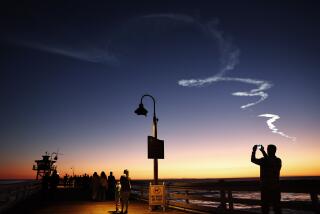NASA dazzled, puzzled by comet Siding Spring data
- Share via
Thousands of shooting stars per hour scraped a yellowed Martian sky last month as a comet blazed through the red planet’s atmosphere at 35 miles per second.
Unfortunately, no one was there to experience the spectacular pass of Siding Spring on Oct. 19, and the remote images and data from the close encounter were not nearly so dramatic.
Still, the space agency has learned surprising things from its extremely rare observations of a comet composed of the matter that formed the inner solar system, scientists said Friday.
“The comet’s dust slammed into the upper atmosphere, creating a massive and dense ionospheric layer, and literally changed the chemistry of the upper atmosphere” of Mars, said Jim Green, director of the NASA Planetary Science Division.
The agency and its European counterpart used more than a dozen instruments and a suite of telescopes to chronicle Siding Spring’s extremely close flyby, when it came within about 87,000 miles of the Martian surface.
But first, they had to make sure their orbiters - Odyssey, Mars Reconnaissance, MAVEN, and the European Space Agency’s Mars Express – were out of harm’s way on the lee side of the comet’s passage. Once the menace of hurtling particles subsided, they got to work.
But data took several days to reach Earth.
“We were all wondering what we would see, realizing that the comet had faded in intensity, wondering if we would see anything at all; we’re all leaning into our screens,” said astrophysicist Nick Schneider or the University of Colorado, who is in charge of MAVEN’s Imaging Ultraviolet Spectrograph.
Amid the routine, background emissions, scientists suddenly saw “this booming signal” of ionized magnesium in the atmosphere of Mars. They also detected iron, sodium, potassium, chromium, manganese, nickel and zinc -- the unambiguous signatures of a comet, Schneider said.
By looking at the brightness and extent of the ultraviolet emissions, researchers estimated that “a few tons,” of dust “covered at least a hemisphere of the planet,” said Schneider. “So it was not an isolated impact,” he added.
NASA’s active Mars rovers -- Curiosity and Opportunity -- don’t capture the kind of images that would show what tons of dust looked like as they streaked across the skies, but that didn’t stop NASA from trying to imagine it.
“It’s looking like that meteor shower must have had thousands of shooting start per hour - possibly, what’s called a meteor storm,” Schneider said. “It must have been a spectacular meteor shower on Mars that night.”
The sodium probably would have left a yellow afterglow visible to the human eye, Schneider said.
NASA did capture some high-resolution images, and it will have to sort through them, pixel by pixel, to figure out the size of the comet’s nucleus and its rotation period.
The spectacle was pretty much over after a few days, and emission signals faded.
“In fact, it’s a little surprising how quickly some of these materials are disappearing,” Schneider said. “We think the chemistry of Mars might be a little different.”
The metals are expected to condense in what’s known as meteoric smoke, a phenomenon seen on Earth, Schneider said. On Mars, that smoke could affect the planet’s interaction with sunlight and cause the formation of high-altitude clouds, according to Schneider.
“It’s possible it could change the chemistry of the atmosphere, just from the addition of these new ingredients,” he said.
Had NASA not sent its satellites to the lee side of the planetary brush-by, they most likely would have been destroyed by what turned out to be a far broader onslaught of dust particles than the space agency initially had anticipated.
“It makes me very happy that we decided to put our spacecraft on the other side of Mars,” Green said. “I really believe that hiding them like that saved them, and gave us a fabulous opportunity to make these observations.”
Feeling like a space cadet? Follow me on Twitter @LATsciguy and “like” Los Angeles Times Science & Health on Facebook.







